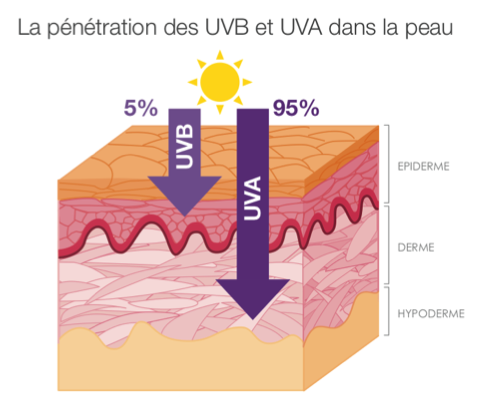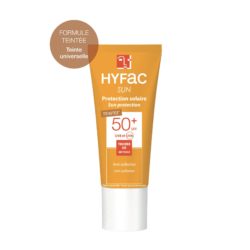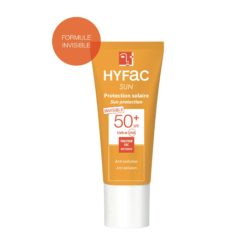
Les conséquences de l’exposition au soleil sur la peau
The sun's rays are essential for the development of our body. They help to fix calcium on the bones and influence our morale. The main beneficial effect of the sun is the heat that it provides us. This heat is provided by the energy delivered by the infrared radiation of the sunlight. The sun warms us up, but this heating must not be excessive so as not to lead to sunstroke. The sun can become an enemy for our skin and eyes. It is therefore necessary to expose yourself with careand fully aware of the risks associated with sun exposure.
What is sun exposure?
Sun exposure includes all the ways in which an individual receives the sun's rays on the skin, whether they are voluntary, unconscious or unwanted. It is therefore not limited to sunbathing on the beach during the summer!
We are exposed to the sun when we work outside, play sports, walk, etc. We are not always aware that we are exposed. We are not always aware that we are exposed. On a boat, for example, the wind cools the skin, so the heat no longer acts as an alarm.
Sun exposure can be acute (intense exposure, leading to sunburn), intermittent (the one that corresponds to our leisure habits, during the holidays for example) or chronicle (this is the case for exposed professions such as farmers or construction workers for example). The latter is an important risk factor for actinic keratoses.
What is in the sun's rays?
Sunlight, whether visible or invisible, is, like radio waves, characterized by its wavelength. The sunlight reaching the earth includes ultraviolet (invisible), visible and infrared (invisible) light.
Visible light has a wavelength between 400 and 700 nanometers. Above this value are the infrared rays (those that warm us up on café terraces), and below 400 nanometers are the rays ultraviolet. They are cold and invisible to the naked eye, hence their danger.

Ultraviolet rays (UV rays) are made up of UVA, UVB and UVC rays. Of all the ultraviolet rays we receive from the sun, 95% are UVA and 5% of UVB. UVC, the most aggressive, is stopped by the ozone layer and therefore does not reach the earth. UVA and B rays reach the earth and penetrate the skin to a depth depending on their wavelength.
UVA rays have a longer wavelength than UVB rays: they pass through glass, penetrate deep into the skin (to the dermis), and accelerate the skin aging. UVB rays are more energetic, they are stopped at the base of the epidermis by melanin (skin pigment cells), cause the sunburns and alter the DNA of the epidermal cells (keratynocytes and melanocytes). They thus participate in the carcinogenesis (carcinomas and melanomas).
The shorter the wavelength of a radiation, the higher its energy, but the less it passes through obstacles.
What is sun capital?
The skin remembers the various contacts with UV rays, this is what we call the "sun capital". Sun exposure is therefore a cumulative phenomenon. L’exposition cumulée aux UV entraîne le vieillissement cutané tout en augmentant le risque de survenue de cancers cutanés.
It is the sun that makes our skin age: wrinkles, spots, loss of elasticity and firmness are the consequence of the action of ultraviolet rays on the skin.
What are the beneficial effects of the sun?
The sun can be an excellent treatment for some forms of seasonal lowsThese symptoms are mainly experienced by women. Those affected experience fatigue, loss of interest in daily life and a strong need for sleep. SAD usually begins in September, increases in winter and improves in spring. These symptoms disappear when the sun returns. It is the light received by the eye that seems to induce signals directly to the epiphysis, a small gland located at the base of the brain, and which would influence the secretion of melatonin.
The sun, and especially UV light, also contributes to the synthesis of vitamin D1It is essential for the fixation of calcium on the bones. In fact, it increases the absorption capacity of calcium and phosphorus by the intestine. A sky, even covered in summer, is sufficient to ensure the synthesis of this vitamin. It is essential to prevent rickets and osteoporosis. It is provided by thepower supply (fish, mushrooms), but this dietary intake is not always sufficient. The recommended daily intake is modulated according to the type of skin and, in pigmented skins or individuals living in latitudes with little sunshine, intakes must be increased. According to a report by the AFSSAPS(1) May 2005, ten to fifteen minutes of sun exposure at least twice a week on the face, arms, hands and back, without sunscreen productare usually sufficient for adequate vitamin D synthesis.
What are the risks of sun exposure?
First of all a sunburn is, apart from its painful aspect, an important aggression for the skin. Sunburn, particularly in children, increases the risk of developing a melanoma (severe cancer developed from pigment cells in the epidermis).
In the early stages leading to the development of skin cancer, changes in the skin are not clinically visible. At first, these changes are only biological at the level of the genes. But they become visible later, with the appearance of dark spotsor small, rough areas of dryness on the face. It is necessary to consult a dermatologist as soon as these first symptoms appear, which may be the precursors of a skin cancer.
If we regularly expose ourselves without protectionThis can lead to the development of skin cancer, particularly on the face and the most exposed parts of the body.
How to identify risk situations?
- Most dangerous hours: between 12pm and 4pm (summer time)
- Reverberation (grass 10%, sand 15%, water 20%, snow 85%)
- In the mountains: altitude and snow increase the amount of UV received by the skin and eyes
- On a boat: the deck, the sails and the foam reflect large quantities of UV. The wind and sea spray refresh the skin, and give a false sense of security
- UV booths
(1) AFSSAPS: French Agency for the Safety of Health Products





